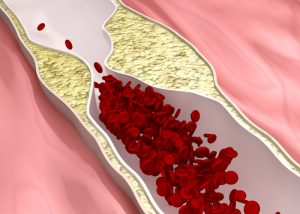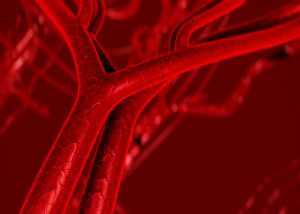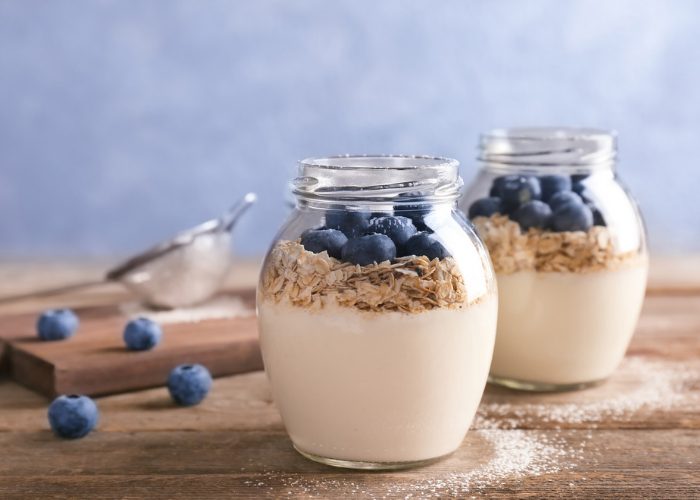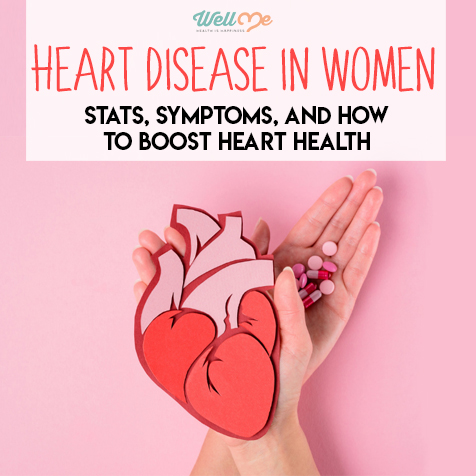Do you look after your heart health? Despite it being
Heart Health 101: What is it?
Before we look at some interesting facts about heart disease in women, it’s worth understanding a little more about the illness. While most people use the term heart disease as a catch-all for cardiovascular problems, there are actually a few different types of heart-related illnesses that you need to be aware of. Here’s a quick rundown of the various types of heart disease and what they entail:
Coronary Heart Disease

The most common type of heart disease in women and men is coronary heart disease (CHD). The problem happens when plaque (fat, cholesterol, and other substances) builds up within the walls of your arteries, which typically carry oxygen to your organs.[2] When you get an increased build-up of this plaque, it results in a condition called atherosclerosis.
After some time, that plaque begins to harden, which means that your
Coronary Microvascular Disease

Another common type of heart disease in women is known as Coronary Microvascular Disease (CMD). In fact, it is more prevalent in women than it is men.[3] Some experts believe that the combination of the main heart disease risk factors, and a drop in estrogen levels thanks to the menopause, is the reason that many women suffer from this condition.
Also known as syndrome X or nonobstructive CHD, this illness occurs when there is damage to the tiniest arteries in your body. Research into what causes this particular type of heart disease in women is ongoing.[4] What’s more, the standard tests that detect whether someone has a heart condition are not able to identify CHD.
Broken Heart Syndrome

While it may have a quirky-sounding name, Broken Heart Syndrome is a serious issue. You are most likely to find this form of heart disease in women than men.[5] Caused by extreme emotional stress, this type of health concern happens when the heart muscle briefly fails. The illness actually has similar symptoms of heart disease, which leads some doctors to misdiagnose the condition. More research into this particular area is needed to determine the exact cause of the problem and how it affects people long-term too.
What Research Says About Heart Disease in Women
Now that you understand the basics

Higher risk of heart disease after giving birth
While there are many risk factors to consider here, when we talk about heart disease in women, it’s worth understanding how childbirth can play a role. Research from the University of Illinois at Chicago found that women are at a higher risk of heart failure in the weeks directly after they’ve given birth.[6] While there was no reason given for this correlation, the experts noted that “high risk” women should be monitored in the weeks after giving birth.
Pregnancy boosts your chances of a heart attack
As women start to have babies later in life, it could have a considerable effect on their health. One study from the NYU School of Medicine found that American women are at high risk of having a heart attack when they are pregnant or giving birth.[7] The experts noted that the general risk of heart attack rises with age too. They

Heart failure kills more women than men
We already know that heart disease in women is a major problem and one of the leading causes of fatalities. To further delve into this issue, one report from the Canadian Medical Association Journal found that death rates from heart failure were higher in women than in men.[8] The study also found that more women than men got hospitalized for the condition overall. The experts did not offer a reason for this trend, but said that more research into the sex differences was needed in the future.
Women don’t get diagnosed fast enough
When we look at the

Hysterectomies increase the risk of heart disease
In some serious medical cases, women have to undergo a hysterectomy operation, i.e. surgery to remove the uterus. Research from the University of Warwick suggests that the removal of ovaries during this procedure can lead to an increased risk of cancer and heart disease in women.[10] While the surgery can help to stop ovarian cancer, it should be noted that it carries a wealth of risks for women and should not be a decision taken lightly.
Disadvantaged women are at risk
Coming from a low socioeconomic background may increase your chances of suffering from some of the most common diseases. Research conducted by the George Institute for Global Health found that disadvantaged women are 25% more likely to develop heart disease than disadvantaged men.[11] The experts suggested that more research into this phenomenon is necessary so that we can understand why it happens.
It’s quite clear that it’s a growing problem. While some initial research into the area has been conducted, we are still learning more about this issue and what we can do to combat it sooner rather than later. With that in mind, let’s take a look at some of the symptoms of heart disease in women and how to prevent it.
What Are the Symptoms of Heart Disease in Women?
As we’ve already covered, at times there are no symptoms of heart disease in women at all. However, some women experience pain in the back, neck, jaw, throat,
While these are the most common symptoms of heart disease in women, recent research suggests that there could be other red flags of which we should be aware. Here are some of the early signs that you may be suffering from the onset of a cardiovascular problem.
1. Unexpected tooth loss

Believe it or not, your dental health may be closely related to your heart wellness. Research from the American Heart Association found that losing teeth when you’re middle aged could be indicative of a high risk of cardiovascular issues.[13] Adults with less than 17 natural teeth were 25% more likely to suffer from heart problems, according to the study.
2. Ongoing shoulder pain

Do you experience pain when you’re lifting heavy items? If the answer is yes, it could be a sign that there’s something not quite right with your health. Research from the University of Utah Health Sciences suggests that shoulder pain is one of the major underlying symptoms of heart disease in women and men.[14] In particular, the study authors suggested that joint pain and rotator cuff injury could indicate poor heart health.
3. Hot flashes

Hot flashes may be a natural part of the menopause, but they could also be a symptom of heart disease in women. One study from The North American Menopause Society found that younger midlife women (between the ages of 40 and 53) who experience hot flashes may be at a higher risk of cardiovascular problems. The reason is that this sign could be indicative of poor vascular function, which can lead to heart disease in the long run.
4. Excess belly fat

Slimming down can be tough at the best of time. But if you’re carrying an excessive amount of weight, it will be putting pressure on your heart. Research from the American College of Cardiology found that both belly fat and “hidden fat” around the abdomen area could be associated with a higher risk of heart disease. The study showed both the density and volume of the fat were factors in indicating whether a person had a heart problem.
5. Deep forehead wrinkles

When you notice the odd wrinkle appearing on your face, it’s nothing to worry about. However, should deep lines have formed in your forehead, it could be one of the symptoms of heart disease in women.
Research from the European Society of Cardiology found that having excessive wrinkles in your forehead – more than seems natural for your age range – could be a sign of heart problems.[15] The researchers suggested that lifestyle factors, such as a stressful job which also puts extra strain on the heart, may be the cause.
Should you notice any of these symptoms of heart disease in women, it could be worth making some small and simple lifestyle changes. Adapting your nutrition plan and activity level could help you to prevent cardiovascular problems in the future. It’s also important that you’re aware of the risk factors so you can address them head-on.
Heart Disease Risk Factors to Watch Out For
The typical lifestyle that you choose to lead has a direct impact on your physical health and, of course, your chances of having a poorly functioning heart. For that reason, you need to be well-versed in the risk factors for heart disease and how they may affect you. Here are some of the most common things you need to know about.

Anxiety and depression
Around 40 million Americans suffer from anxiety disorder, while 16.1 million suffer from
Suffering from either disorder may increase the chances of heart attacks in women over the age of 45, according to research from the American Heart Association.[17] Finding ways to battle the problem is the smartest thing you can do for your health. You might want to look for small lifestyle changes that will relieve your daily stress levels or seek professional advice from a counselor. Get the help you need when you need it.
Diabetes
More than 100 million American adults now live with either prediabetes or diabetes, according to national statistics.[18] The problem can impact all areas of a person’s life, but could also increase your chances of getting heart disease in the long term.[19] Being aware of the condition you have and taking measures to manage it could be the key to warding off any further medical conditions. When in doubt, seek medical advice on this issue.

Physical inactivity
Do you lead a sedentary life? Or, on the other hand, do you try to be as active as possible? Your level of physical activity has a direct impact on how likely you are to develop a heart condition. A low level of physical activity is one of the major risk factors in heart disease.[20] Increasing your fitness level by heading to the gym, walking to work, doing a yoga or pilates workout, or just going out for a quick jog each day could be the answer.
Need some encouragement to get out of bed for a workout? Don’t worry, even the fittest of us do, sometimes! These 10 exercise motivation tips will be just the kick to get you started!
Overweight and obesity
Of course, a direct result of physical inactivity is being overweight or even obese. Around two-thirds of American adults are now considered either obese or overweight, according to national statistics.[21] If you’re currently struggling with weight issues, it’s important that you take action and do something to manage the ongoing problem. Both of these issues are major risk factors in heart disease so they are worth knowing about. Changing your diet and increasing your level of activity could be the way to go here.
Excessive alcohol use
Having the odd tipple now and then may be no big deal, but if you’re drinking excessively, you could find that it impacts your general health in a huge way. Drinking too much is one of the risk factors in heart disease but is all too often overlooked by people.[22]
Two out of three adult drinkers say that they drink more than a moderate amount at least once a month.[23] Sure, curbing this habit may not be easy, but it could be one of the keys to boosting your heart health and, in fact, your overall wellness.
5 Easy Ways to Boost Your Heart Health
The statistics and facts on heart disease in women are shocking. Once you’ve learned about them, there’s likely to be one burning question on your mind. What can you do to help boost your heart health and avoid the risk of heart disease? The truth is that there are many ways in which you can prevent this health problem. Let’s take a look at just five of the lifestyle changes you could start making today that will be a huge help.
1. Stay as fit as possible

As we’ve already covered, leading a physically inactive lifestyle is seriously detrimental to your heart health. That means that one of the ways in which you could boost your cardiovascular fitness is to start a new activity regime. Of course, the most obvious ways in which you can do this is to join a gym or even hire a personal trainer.
However, that option does not fit with everyone’s lifestyle. You could also invest in a bike and start cycling, take up swimming lessons, or even join some dance classes. Find the type of activity that suits your life and get started as soon as possible. The sooner you begin to make these small changes, the sooner you will reap the physical rewards.
2. Stick to a low-fat diet

It hardly takes Sherlock Holmes to deduce that your diet and wellness are linked. Research from the Medical College of Georgia at Augusta University found that high-fat diets are associated with a higher risk of heart disease.[24] The study looked at the effect a high-calorie whole milkshake has on the blood vessels and how it leads to heart disease. The study showed that consuming a single high-fat treat could have worrying results.
Changing your diet may seem like a huge lifestyle change, but it doesn’t have to be. You simply need to make some minor changes to the way that you cook and eat. Planning your meals ahead of time will mean that you manage them better and make healthier choices. You may also want to swap high-fat food, such as red meat, for low-fat choices like tofu.
If you’re planning to switch up your diet for the better, there are so many healthy options to choose from. Perhaps you’d like to try the keto diet, or the longevity diet plan. Or maybe even try your hand at going vegan, or if that’s too much, becoming a flexitarian!
3. Relieve some of your stress

We already know that anxiety and depression could be linked to heart disease in women, but what about stress? Research from The Lancet suggests that
The National Health Service suggests that there are many ways in which you could try to combat your increasing stress levels.[26] You might want to connect with your social circle and get some support from them. Increasing your activity levels, managing your workload, and having some time to yourself may also help. The NHS also says that you might want to challenge yourself in some way too, which could help you to relieve your stress. For example, you could learn a new language or take a class on music. Should you find that stress is hindering your life in a serious way, though, it’s worth seeing a doctor.
4. Get a good night’s sleep

Do you find it hard to nod off at night? If so, it could be increasing your risk of heart disease in the long run. Research from the European Society of Cardiology suggests that poor levels of sleep can actually boost your chances of having heart problems and a stroke.[27] While many of us find it hard to drop off to sleep, doing what you can to ensure that you get some proper rest needs to be a priority.
When you’ve identified that there’s a problem, you need to act. The National Health Service recommends some of the ways in which you may want to improve your sleep each night.[28] For example, you should make sure that you head to bed at the same time each night so that you keep to a stable routine. You also need to have some downtime right before you hit the hay so that you can wind down and prepare for bed.
Thinking of using a sleep tracker? If you scratch below the surface, sleep trackers are not as effective as they are marketed to be. Be sure to do your research before you start using one.
5. Try to eat less salt in your diet

How much salt do you currently consume? You might not even be aware that eating a high-salt diet could mean that you’re at risk of heart problems. Research from the European Society of Cardiology suggests that having a high salt intake could as much as double your risk of heart failure.[29] Cutting back may be hard, but it’s worth it. Be sure to check the ingredients before eating snacks and using less salt when you’re cooking.
The Best Foods, Supplements, & Vitamins for Heart Health

Ready to improve your heart health? Changing the things that you eat and taking some supplements could be one way you can lower your overall risk of heart problems in the future. Since a poor diet is a major risk factor, the sooner you make some changes, the better you will feel. Here are some of the best foods, supplements, and vitamins to give your cardiovascular health a boost
Vitamin D

One study from Johns Hopkins Medicine found that a combination of regular exercise and vitamin D leads to a healthy heart.[30] The research looked at the health records of over 10,000 American adults over a 20-year period to get these results. Fatty fish, orange juice and soymilk are all foods that are high in this particular vitamin. However, if you feel that you are lacking in it, you can also get over-the-counter vitamin D tablets, which you can take on a daily basis.
Leafy greens

Do you make sure to get a regular fix of green vegetables? If the answer is no, you need to change your ways! Research suggests that eating leafy greens can help to lower your blood pressure.[31] Since high blood pressure is linked to cardiovascular problems, trying to lower it the best way you can is a positive step toward better heart health. Why not start small by adding some spinach, kale, or other leaves to your meals today?
Berries

There’s nothing quite as nice as snacking on some delicious and healthful berries. Scientific research shows that eating berries can help to reduce some of the risk factors of heart disease. For example, one enlightening study found that eating berries could help to lower bad cholesterol in a person’s body.[32] That small change could make a huge difference when it comes to your overall risk of cardiovascular problems.
Dark chocolate

Looking for a handy excuse to eat more chocolate? You might just have found it! The National Heart, Lung, and Blood Institute Family Heart study found that eating dark chocolate on a regular basis could have a dramatic effect on your heart health.[33] The results found that participants who ate the sweet yet bitter snack at least five times a week had a lower risk of coronary heart disease than those who didn’t eat chocolate at all.
Nuts

While we’re on the subject of snacks, here’s one type that you don’t want to overlook. Nuts are an excellent source of healthy fats. But that’s not the only reason you should be chomping on them! Research from the American College of Cardiology found that eating a variety of nuts is directly linked to a lower chance of heart disease in women and men.[34] You could either add nuts to some of your favorite recipes or simply snack on them. Of course, you should make sure that you don’t over-indulge here as nuts are calorie-rich.
Yogurt

Whether you enjoy it for breakfast or eat it as a sweet dessert, consuming some healthy natural yogurt could be a fantastic way in which you can boost your heart health. What’s more, it’s so easy to make your own all natural yogurt at home! One study published in Oxford University Press USA found that eating yogurt could help to decrease a person’s chances of developing cardiovascular disease.[35] The research found that both hypertensive men and women could benefit from this type of snack. There are plenty of ways you can get more yogurt in your diet. Why not include it in a DIY superfood smoothie or just eat it straight from the tub?
Avocado

It’s the latest food trend, but the humble avocado may be more than just an Instagrammable fruit. Research has found that eating avocados on a regular basis could help to reduce levels of bad cholesterol in a person’s body.[36] What’s more,

Conclusion
Heart disease in women is a serious issue that shouldn’t be taken lightly. This guide gives you a baseline understanding of the associated health conditions and the factors that affect it. Now, it’s over to you. If you want to improve your heart health, you now have the tools to do so. Follow the advice that we’ve laid out here and start revamping your lifestyle. After all, there’s nothing more important than your heart health.
References
- [1] https://www.cdc.gov/dhdsp/data_statistics/fact_sheets/fs_women_heart.htm
- [2] https://www.nhlbi.nih.gov/health-topics/heart-disease-women
- [3] NHLBI. https://www.nhlbi.nih.gov/health-topics/heart-disease-women
- [4] https://www.nhlbi.nih.gov/health-topics/heart-disease-women
- [5] https://www.nhlbi.nih.gov/health-topics/heart-disease-women
- [6] Circulation Heart Failure. https://www.ahajournals.org/doi/10.1161/CIRCHEARTFAILURE.117.004005
- [7] https://nyulangone.org/press-releases/heart-attack-risk-on-the-rise-for-pregnant-women-death-rate-remains-high
- [8] http://www.cmaj.ca/content/190/28/E848
- [9] The Annals of Thoracic Surgery. https://www.annalsthoracicsurgery.org/article/S0003-4975(17)30951-7/fulltext
- [10] https://www.bmj.com/content/356/bmj.j372
- [11] https://jech.bmj.com/content/71/6/550
- [12] CDC. https://www.cdc.gov/dhdsp/data_statistics/fact_sheets/fs_women_heart.htm
- [13] https://newsroom.heart.org/news/middle-aged-tooth-loss-linked-to-increased-coronary-heart-disease-risk?preview=4044
- [14] https://insights.ovid.com/crossref?an=00043764-201702000-00004
- [15] ESC. https://www.escardio.org/The-ESC/Press-Office/Press-releases/Deep-forehead-wrinkles-may-signal-a-higher-risk-for-cardiovascular-mortality
- [16] https://adaa.org/about-adaa/press-room/facts-statistics
- [17] http://newsroom.heart.org/news/anxiety-depression-other-mental-distress-may-increase-heart-attack-stroke-risk-in-adults-over-45
- [18] CDC. https://www.cdc.gov/media/releases/2017/p0718-diabetes-report.html
- [19] https://www.cdc.gov/dhdsp/data_statistics/fact_sheets/fs_women_heart.htm
- [20] https://www.cdc.gov/dhdsp/data_statistics/fact_sheets/fs_women_heart.htm
- [21] NIDDK. https://www.niddk.nih.gov/health-information/health-statistics/overweight-obesity
- [22] https://www.cdc.gov/dhdsp/data_statistics/fact_sheets/fs_women_heart.htm
- [23] https://www.cdc.gov/alcohol/fact-sheets/moderate-drinking.htm
- [24] Augusta University. http://jagwire.augusta.edu/archives/52420
- [25] https://linkinghub.elsevier.com/retrieve/pii/S0140673616317147
- [26] https://www.nhs.uk/conditions/stress-anxiety-depression/reduce-stress
- [27] European Society of Cardiology. https://www.sciencedaily.com/releases/2017/08/170829091040.htm
- [28] https://www.nhs.uk/live-well/sleep-and-tiredness/how-to-get-to-sleep
- [29] https://www.escardio.org/The-ESC/Press-Office/Press-releases/esc-congress-2017-hot-line-tips?hit=wireek
- [30] The Journal of Clinical Endocrinology & Metabolism. https://academic.oup.com/jcem/article/102/4/1227/3002901
- [31] https://www.ncbi.nlm.nih.gov/pmc/articles/PMC4288952/
- [32] https://www.ncbi.nlm.nih.gov/pubmed/20797478
- [33] NCBI. https://www.ncbi.nlm.nih.gov/pubmed/20858571
- [34] https://www.sciencedirect.com/science/article/pii/S0735109717398224?via%3Dihub
- [35] https://academic.oup.com/ajh/article-abstract/31/5/557/4818397?redirectedFrom=fulltext
- [36] NCBI. https://www.ncbi.nlm.nih.gov/pubmed/25567051








